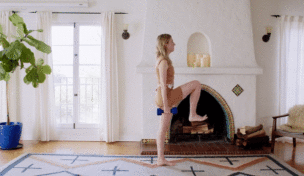
Exercising in your 60s+
Jun 24, 2022 - Jennifer DeValue
My mom has tapped into a determination to address aging like a champion.
Even despite a lupus diagnosis she has remained relatively spry. Staying as mobile as possible has always been her goal. As her sixties move along, that’s becoming increasingly more difficult. But, God help her, she refuses to quit. Our pantry has been converted into her gym. Every day, I walk in to find her using our groceries for squats or lifts.
She is a living, breathing, soup-can-lifting poster child for how exercise slows aging.
Well the effects of it anyhow. For thirty years, she’s battled with the fact that her body was aging faster than it should. Her weapons of choice? Walking. Swimming. Campbell’s and Goya (apparently). Just like Meghan’s mom who found her equestrian calling in her 60s, it took a lot of moxie. You have that same moxie. We all do. It just takes the right incentive to initiate it.
Key benefits of exercising after 60
In your 60s the hustle and bustle of life is quieting down. This calming period is noticeable whether you’re an empty nester reclaiming independence or a life-long bachelor(ette) redefining your identity.
This settling into your older, wiser years is probably also coming with some noticeable physical changes. Perhaps the most crucial benefit of exercising through these transformations is that you’ll barely feel them!
Exercising in your 60s isn’t some far flung idea. The benefits far outweigh any perceived “risk” you might be working up in your mind’s eye.
They include:
Preventing Bone Loss: Maintaining strong bones will keep you on your feet and mostly intact for as long as possible. Keeping your bone health in mind means preventing avoidable fractures and other injuries.
Relieves Osteoarthritis Pain: Stiffness and arthritis should be incentives, not barriers to exercising in your 60s. Low impact training keeps your blood circulating and the muscles around your bones strong. How? By taking the pressure off the joints.
Helps Prevent Chronic Disease: No matter which “inevitable” affliction gives you the most anxiety, exercise can help ease your mind and body at the same time. Cardiovascular and Alzheimer’s disease are just two of the illnesses that studies believe are alleviated by regular exercise.
Boosts Immunity: This goes hand in hand with our last point. With the caveat that we are now talking about your daily health. Exercise supports your body’s ability to fight off invading germs. Que 80’s nostalgia training montage!
Improves Mood: Your overall sense of wellbeing starts with how you feel about your body and how your body feels. With exercise comes peace of mind, relaxation, and a sense of achievement. What could be better?
Recovery as we age lasts longer than we expect (or want it to). Be compassionate to your body and understanding with yourself. It’s important to find the best self-care for you, not fight the aging process tooth and nail.
What types of exercise are best for those over 60?
If you already have a program that you like and feels good, continue with that.
If you need to start moving again, start with walking. It’s so fundamental and organic, that it’s impossible to get wrong. Besides that, the risk of injury is low and the sense of adventure is high. Visiting a new area of town can revitalize your mind alo
Better yet, come take a roll on the mat with Meghan’s individually curated Pilates programs. Don’t let the words “strength” and “mobility” training make Pilates (or any exercise for that matter) feel like it’s out of your reach. Pilates is low impact and will increase the mobility and movement of your joints.
Getting on and off the floor every day has the added benefit making you feel like your younger self.
Once you’re in a good rhythm start adding balance training to your program. It’s an unfortunate truth that our reflexes and ability to balance diminish as we age. Thinking about balance before the 65+ age range will prepare you physically and mentally. Practicing balance when you’re already feeling the “wobble,” can help keep you on your feet. Literally.
Do’s and Don’ts:
Do: Find an exercise activity that engages your brain and body.
Don’t: Go from 0-60. There’s no making up for time, and trying with a high intensity exercise will do more harm than good.
Do: Set a schedule and/or daily goals.
Don’t: Stress a missed session here or there. It’s important, but not critical.
Do: Use whatever you have in the pantry for weights (within reason). Canned soup, water gallons, and (my personal favorite) baked beans are a less expensive, more versatile substitution for the classic “dumbbell.”
Don’t: Be self-conscious. I know, easier said than done. You’ve got this far through life… I’m sure there was at least a modicum of not caring what others think in there somewhere. Channel your inner rebellious teen and show the world what you’ve got!
Conclusion
You don’t need special equipment to exercise. Except if you’re Meghan’s mom… she needs a horse. For you non-equestrians, though, Campbell’s has your back.
Whether you’re starting, restarting, or continuing your exercise routine, always find an activity that you enjoy. Taking care of yourself shouldn’t be a chore, it should be a priority.
While strength and mobility training are important, balance is crucial. Meghan has some great videos on simple balancing techniques and workouts you can try. Even in the privacy of your own home.
Don’t feel embarrassed, feel encouraged. Your body is as beautiful/handsome today as it ever was, just in a different way. Once you respect that, your confidence will soar.
So start something good.





